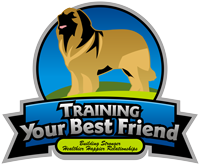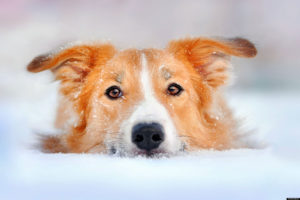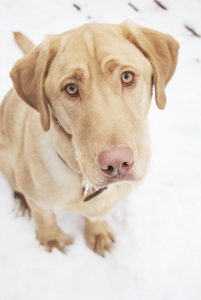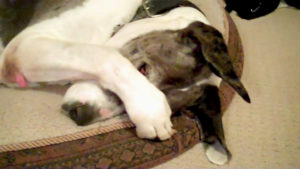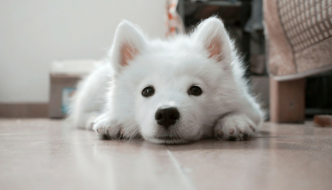
How to Increase Your Dogs Focus & Impulse Control
How attentive is your dog? Whether you realize it or not you’re probably already the center of his universe – at least until that squirrel runs by.
When you come home I bet you’re greeted with a wagging tail, and when you get up to make dinner I bet all eyes are on you. Taking advantage of your dogs natural observational skills and adding in some focus will make your dog training so much easier.
Young Dogs Often Lack Focus and Impulse Control
If you’re raising a puppy or teenage dog you already know how challenging it can be. Puppies aren’t known for their amazing attention spans. And when they hit adolescence it’s like they wake up one day and have forgotten everything. They don’t listen, they roam, and they have a mind of their own.
Luckily working on some focus behaviors and practicing impulse control will help. Great focus & impulse control will make all of your training so much easier.
Have you seen those agility trials where those dogs are constantly focused on their handler? Ever wonder in the world how they were able to get that sort of focus from their dogs.
It just takes consistency and practice. Here’s some simple tips to easily increase your dogs focus and impulse control that you can do today.
Is Your Dog Easily Distracted?
When it’s time to train your dog do you find yourself competing for his attention? Does he become easily distracted by other dogs or people? Does he go off and follow his nose rather than listen to you? Does he get overly excited by noise or movement?
If you answered yes to any of the above working on some focus and basic impulse control work will benefit you and your dog. Having your dog focused and attentive to your commands will make all of your future training sessions easier. It all starts with a good foundation built on trust, focus, and lots of impulse control work.
Start With Realistic Goals For Your Dog
Imagine yourself at the dog park with Fido on a nice summer day. When you open that gate I bet your dog is interested in everything but you.
For most of dog owners having great focus while surrounded by such chaos doesn’t seem obtainable, it actually seems impossible. It’s something only advanced dog owners do; they’ve even got dog training classes specifically for that purpose.
While it’s certainly not easy it is obtainable. If you start with realistic goals and build on your success you can have an attentive dog in those sorts of situations as well. But like many other great things in life it’s not quick, it’s not easy, and it takes a lot of hard work.
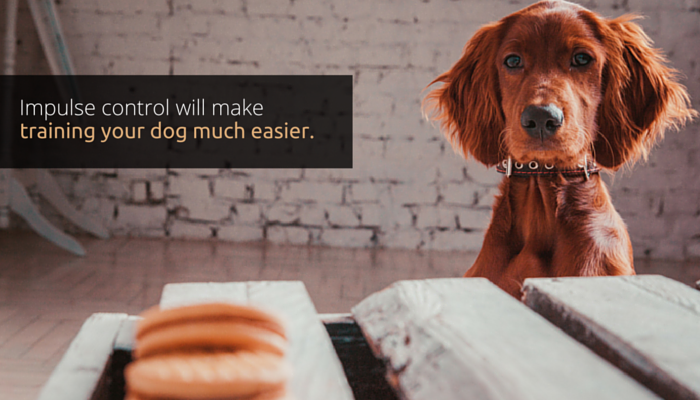
How Impulse Control Leads to Easier Training
Once your dog has great focus & impulse control all of your training goals will be much easier to accomplish. Many of my dog’s problems had to do with our daily dog walk.
Once you’ve got the the basics mastered you can move on to more distracting locations.
Remember that impulse control in one situation will affect arousal and control in another. So that if our dog goes bonkers over squirrels and over tennis balls, say please by sitting in order to play fetch is important for getting him to behave well around squirrels too.
How to Increase Your Dogs Focus & Impulse Control
Start small, set realistic goals, and build on your prior successes. It all sounds so simple – and it is, but staying consistent is where a lot of us fail.
The general goal of all dog training is to teach our pets impulse control. We want them to resist their immediate desires and, instead, comply with our cues or commands. Accomplishing this allows us to keep our pets under control, ensuring their safety and comfort, as well as the safety and comfort of others.
Start By Teaching Your Dog to Look at You
The first step in increasing your dogs focus is to have them offer it willingly. With yummy treats in hand call your dog by his dog to get your dogs attention. As soon as he looks at you drop a treat for him.
After he’s had that first treat he’ll make his next choice – either to look back up at you, or to explore everything else around him. Once he decides to look back up at you, reward again – don’t be afraid to show him how proud you are with lots of praise.
Use Verbal cue- “Watch Me”. What you’re looking for is your dogs willingness to stop, look at you, and wait patiently before proceeding. When you build on this behavior your dog is not only learning to focus more on you because you’re the bearer or all good and exiting things – you’re also teaching him impulse control.
Gradually increase the amount of time your dog has to look at you for his reward. If he gets pushy or jumps up to get more treats ignore him. Only treat when he’s calmly looking up at you. Eventually your dog should be able to sit calmly looking up at you for 5-10 seconds. Keep these training sessions short and sweet (3-5 minutes each session). Just like many of us our dogs get bored when asked to do the same thing for extended periods of time.
Up The Ante – Have Your Dog Wait for a Highly Prized Treat
Grab a big piece of ham or some other highly valued treat (or toy) and repeat the first step – waiting for a calm look.
Play the Open Hand Game/Teaching Leave It
While sitting down or leaning over place some treats in your hand and leave it open for your dog to see. If your dog goes to grab the treats close your hand – only open it again once he’s sat back down or backed off. Keep your hand open at all times unless your dog goes to snatch the treats out of it.
If your dog nudges or scratches your hand keep it closed and wait. Only open it back up once he’s calm and not actively trying to get the treats. Reward him if he chooses to look at you rather than the treats. Eventually your dog will learn to respect your space and look at you for their next cue.
You can also work on leave it by placing a treat or toy on the ground and rewarding your dog for ‘leaving it.’
Teaching a “Settle Down” Command
Not all dogs are naturally calm; some need to be taught to relax. Many people choose to use a mat or dog bed for the “settle down” command.
Continue to Reward Patient Behaviors From Your Dog
Once you’ve done a few impulse control sessions with your dog you can apply it to any other daily routines or experiences. A lot of people have their dogs sit and wait before eating. Others make sure their dog is sitting calmly before letting visitors inside. Many people wait for their dog to sit calmly before leaving for the daily walk.
Decide how you’d like your dog to react in given situations and give him a chance to work at it. Some situations will be much tougher than others but with consistency you can teach your dog to remain calm.
After awhile it becomes so natural that you might not even have to ask your dog for certain behaviors – he’ll start doing them on his own. Don’t forget to keep up with the praise and consistency.
Don’t leave your dog guessing – if he does something desirable make sure to let him know. With every positive reinforcement he receives the more likely he is to repeat that behavior in the future.
Make Training Easier by Practicing Focus & Impulse Control
Increasing your dogs focus and impulse control will make tackling any new so training much easier. Once your dog starts looking to you for the next cue you become his main focus. Dogs are always looking to us for cues; don’t leave them hanging, and don’t give them mixed messages. They spend a lot of time trying to figure out what we want – make it easy for them by showing them.
Take the time to work on some basic impulse control. A great canine human relationship is about more than just food, love, and shelter – it’s also about maintaining good communication.

